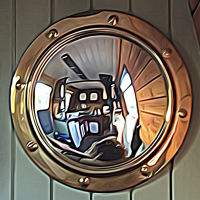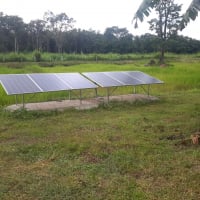Wiring 12v battery bank for best efficiency

WeeVee
Registered Users Posts: 4 ✭
Hello all, I'm somewhat of a novice to all this so please forgive me if I'm asking obvious questions.
We have a bank of 4 x 130Ahr leisure batteries aboard our narrowboat, charged by a 495w solar system and the 70A engine alternator.
The batteries are wired in parallel at present (I've attached a very basic wiring diagram of our current setup).
I've been doing some reading on wiring batteries for longer life/best efficiency, which has turned into a bit of a minefield. There seems to be conflicting ideas on how best to do it. I wondered if I could get some advice please.
I've been doing some reading on wiring batteries for longer life/best efficiency, which has turned into a bit of a minefield. There seems to be conflicting ideas on how best to do it. I wondered if I could get some advice please.
The only thing I should mention is our battery bank is spilt, with two on the LHS on the boat and two on the RHS. This makes having all cables the same length pretty difficult .
.
 .
.
Tagged:
Comments
-
Because the battery bank is the heart of the system, it's best to start there, if the physical layout is as depecticted in the diagram, that is probably the worst configuration possible to achieve ballance. The positive and negative connections should be diagonally opposite, which although not perfect is better than the diagram illustrates. Your response will initiate a flow of responses, for now focus on the battery configuration, then move on to other potential discrepancies.1500W, 6× Schutten 250W Poly panels , Schneider MPPT 60 150 CC, Schneider SW 2524 inverter, 400Ah LFP 24V nominal battery with Battery Bodyguard BMS
Second system 1890W 3 × 300W No name brand poly, 3×330 Sunsolar Poly panels, Morningstar TS 60 PWM controller, no name 2000W inverter 400Ah LFP 24V nominal battery with Daly BMS, used for water pumping and day time air conditioning.
5Kw Yanmar clone single cylinder air cooled diesel generator for rare emergency charging and welding. -
Thanks for your reply.They are joined exactly as my diagram, although their actual location in the engine bay differs slightly.There are two batteries on the swim of the starboard side and two on the swim of the port side. The cables between batteries two and three are longer to accommodate this. This rules out being able to have equal length cables throughout.
-
No, it really doesn't. Just make sure all the connections between individual batteries in the bank are the same length. e.g. red and black between 1 and 2 are both 1 foot, between 2 and 3 are 20 feet (or whatever it takes to go between the sides of the boat), between 3 and 4 are 1 foot. Then connect to the bank with diagonal connections, as mentioned. e.g. black to battery 1, red to battery 4. The length going to each battery will be the same.WeeVee said:Thanks for your reply.They are joined exactly as my diagram, although their actual location in the engine bay differs slightly.There are two batteries on the swim of the starboard side and two on the swim of the port side. The cables between batteries two and three are longer to accommodate this. This rules out being able to have equal length cables throughout. -
Got you, thanks Mike.My cables are matched as you describe, so the only change I'd need to make to my current setup would be to move the shunt negative from battery 1 to battery 4?Hoping I've understood correctly.
-
Yep. And all the positive connections should go to battery 1 - using a buss bar will make it easier.WeeVee said:move the shunt negative from battery 1 to battery 4? -
Here is a website that suggests some battery wiring options for better balance:
http://smartgauge.co.uk/batt_con.html
And the use of fuses/breakers to reduce the chances of short circuits/fires. Each + wire (assuming negative grounded DC power system) should have a fuse/breaker rated to protect that wire from over current (short circuits). The fuse/breaker is typically mounted as close to the battery bank as practicable. Lead acid batteries, and particularly a bunch connected in parallel can output 100's to 1,000 Amperes into a dead short. Breakers are nice because you can also use them as an On/Off Switch too (breakers and fuses need to be rated for DC use).
For charging via solar--Two calculations are suggested... One based on the size of the battery bank, the second based on your actual power usage and hours of sun per day (Guessing you are in the UK--Being Narrow Boat is a term for boats that are using the large canal network in the UK, and I checked your IP address/location as a moderator).
Solar Panels... 1-2% rate of charge for purely "floating/storage of a charged battery bank" (off season). 5% minimum suggested rated of charge for a daily cycling battery bank... 10%-13% to as high as 20% for full time off grid system (more panels, less genset usage). The math would be:- 4 * 130 AH= 520AH @ 12 volts (house bank)
- 520 AH * 14.5 volts charging * 1/0.77 panel+controller derarings * 0.02 rate of charge = 196 Watt float/storage
- 520 AH * 14.5 volts charging * 1/0.77 panel+controller derarings * 0.05 rate of charge = 490 Watt minimum
- 520 AH * 14.5 volts charging * 1/0.77 panel+controller derarings * 0.10 rate of charge = 979 Watt nominal
- 520 AH * 14.5 volts charging * 1/0.77 panel+controller derarings * 0.13 rate of charge = 1,273 Watt typical "cost effective" maximum
To estimate sizing your solar array based on energy usage... You can get the hours of sun per day based on your location you cruise mostly, and also look at tilting vs flat mounted panels and how it affects your solar harvest. For example, Leeds UK, facing south, flat vs 36 degrees from vertical (or 54 degrees from horizontal):
http://www.solarelectricityhandbook.com/solar-irradiance.htmlLeeds
Measured in kWh/m2/day onto a horizontal surface:
Average Solar Insolation figuresJan Feb Mar Apr May Jun 0.64
1.31
2.20
3.37
4.44
4.51
Jul Aug Sep Oct Nov Dec 4.50
3.82
2.59
1.54
0.80
0.51
Leeds
Measured in kWh/m2/day onto a solar panel set at a 36° angle from vertical:
Average Solar Insolation figures
(For best year-round performance)
You can pick the angle that works best for you (fixed docked location, or variable as unknown left/right bank/which way is south, etc.). Solar is not great in the UK in general, and during winter, it is hard to get enough sun to be cost effective with solar only. For example, lets say you use 1/4 of your battery capacity overnight/daytime:Jan Feb Mar Apr May Jun 1.16
2.04
2.67
3.47
4.03
3.89
Jul Aug Sep Oct Nov Dec 3.97
3.76
3.03
2.25
1.39
1.00
- 12 volts * 130 AH * 0.85 AC inverter eff = 1,326 Watt*Hours per day
- 1,326 WH per day * 1/0.52 off grid AC Solar system eff * 1/3.0 hours of sun (April-September) = 850 Watt Array minimum
I guess most of your travels are in fresh water (not salt)--But things can be pretty complicated when dealing with electricity and boats. Shore power/grounding/zinc blocks/avoiding currents that can corrode the propeller and bearings...
Not sure exactly how far you want to go down this rabbit hole of safety... Here is a quick summary of some of the issues:
https://www.westmarine.com/WestAdvisor/Ten-Deadly-Conditions
Anyway, welcome to the forum WeeVee, and let us know how you would like the conversation to proceed.
-BillNear San Francisco California: 3.5kWatt Grid Tied Solar power system+small backup genset -
Many thanks Bill, I'm going to pour a glass of red and digest all of that.
 We do have the option of shore power when in a marina and it is covered by an RCD breaker. Although we continuously cruise most of the year so we are keen to get our setup as efficient as we can.Unravelling the DIY electrical alterations and additions on our 30 odd year old narrowboat is proving to be quite an adventure.We are indeed mostly fresh water travels (UK inland canals), with the odd tidal estuary. We have sacrificial anodes and a galvonic isolator fitted to the old girl.I'm bound to have some more newbie questions after reading your info, so I'll pop back then.Thanks again for taking the time to put it all together.
We do have the option of shore power when in a marina and it is covered by an RCD breaker. Although we continuously cruise most of the year so we are keen to get our setup as efficient as we can.Unravelling the DIY electrical alterations and additions on our 30 odd year old narrowboat is proving to be quite an adventure.We are indeed mostly fresh water travels (UK inland canals), with the odd tidal estuary. We have sacrificial anodes and a galvonic isolator fitted to the old girl.I'm bound to have some more newbie questions after reading your info, so I'll pop back then.Thanks again for taking the time to put it all together.
Categories
- All Categories
- 233 Forum & Website
- 141 Solar Forum News and Announcements
- 1.4K Solar News, Reviews, & Product Announcements
- 199 Solar Information links & sources, event announcements
- 900 Solar Product Reviews & Opinions
- 256 Solar Skeptics, Hype, & Scams Corner
- 22.5K Solar Electric Power, Wind Power & Balance of System
- 3.5K General Solar Power Topics
- 6.7K Solar Beginners Corner
- 1K PV Installers Forum - NEC, Wiring, Installation
- 2.1K Advanced Solar Electric Technical Forum
- 5.6K Off Grid Solar & Battery Systems
- 429 Caravan, Recreational Vehicle, and Marine Power Systems
- 1.1K Grid Tie and Grid Interactive Systems
- 656 Solar Water Pumping
- 816 Wind Power Generation
- 624 Energy Use & Conservation
- 623 Discussion Forums/Café
- 315 In the Weeds--Member's Choice
- 75 Construction
- 125 New Battery Technologies
- 108 Old Battery Tech Discussions
- 3.8K Solar News - Automatic Feed
- 3.8K Solar Energy News RSS Feed
